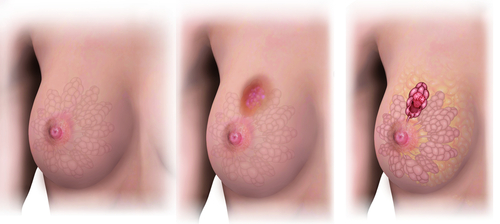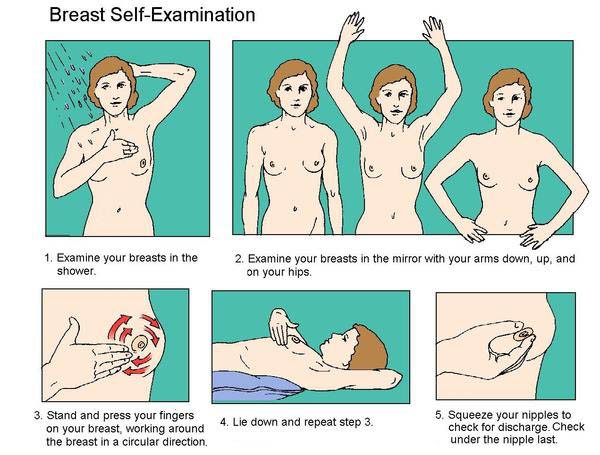Latest Edit: Hector 2014-01-02 (EDT)
Breast cancer describes tumors of the breast and chest wall. The most common type arises from the milk ducts and is called invasive ductal carcinoma. Less common types include lobular carcinoma and inflammatory breast cancer. Breast cancer can spread to the surrounding breast and chest wall tissue, liver, lungs, brain, and bone, amongst other locations.
Breast cancers develop in 124 out of every 100,000 women, and the incidence of the disease is increasing. [1] While most breast cancer patients are women, it is possible for men to develop breast cancer.
Signs and symptoms that may lead a doctor to rule out breast cancer include a breast lump, rash, skin thickening, nipple inversion, or abnormal nipple discharge. A lump that persists through the menstrual cycle is more concerning than one that grows and shrinks throughout the cycle.
Naturopathic Assessment
| Read this article |
Being proactive about your breast health, [1]; Canadians Women's Health Network Feb 2013 |
|---|
Causal Factors
In order to stimulate the innate ability of the body to heal the causes of disease must be identified and addressed. With breast cancer, the causes are variable and include lifestyle and environmental factors. A detailed assessment is required to determine which factors are contributing to the development and growth of breast cancer.
| Article |
Soy and breast cancer: What are you telling your patients?, IHP, September 2009 |
|---|
| Article |
The Effects of Soy Consumption on Breast Cancer Prognosis , January 2013 Natural Medicine [2] |
|---|
| Article |
Vegetables Reduce the Risk of Breast Cancer Recurrence , 2010 August Natural Medicine [5] |
|---|
| Article |
Scientific Evidence Confirms the Influence of Diet on Breast Cancer Risk, 2010 May Natural Medicine [6] |
|---|
- Physical activity decreases breast cancer risk and improves survival in people with breast cancer. For women with breast cancer, walking 1-3 hours a week decreases the risk of dying from breast cancer by 20-50%.[3]
- Another study regarding the impact of exercise on life span overall found that even 15 minutes of daily activity lengthens life expectancy by 3 years, within an increase of life for each additional amount of exercise. [4]
- Obesity increases the risk of breast cancer. Fat cells make estrogen and inflammatory cell signals (cytokines), both of which stimulate the growth and development of breast cancers. Fat also stores and concentrates environmental chemicals. Chemicals made from petroleum or plastics are fat soluble, easily stored in fat, and are poorly excreted by the body.[5]
- Chronic stress is associated with increased risk of breast cancer.
| Article |
Environmental Links to Breast Cancer and Endometriosis, NDNR [7], 2011 February |
|---|
| Article |
Cadmium exposure and breast cancer: A hypothetical case presentation, IHP, September 2009 |
|---|
- Some breast cancer activists are concerned about "pink washing" by companies that both manufacture carcinogenic products and support breast cancer research.[9] [10]
- Non-stick coatings on cookware and flame retardants in carpet and upholstery cause breast cancer in animals. These chemicals build up in body fat, leading to cumulative doses from multiple low level exposures.[11]
| Article |
"BRCA Methylation Implicated in Breast Cancer Carcinogenesis", NMJ, [8], 2011 December |
|---|
- There tends to be a familial link to breast cancer risk. This is due to both inheritable genetics and to lifestyle and environmental traits that are shared among families.
- Genetic syndromes associated with familial breast cancer include BRCA mutation, hereditary breast and ovarian cancer syndrome, and possibly Lynch syndrome .[12]
- Some breast cancers have the Her-2-Neu receptor and gene activated. Her-2-Neu drives tumor growth and is a potential target for therapy. [13]
| Article |
Radiation Therapy for Breast Cancer Causes Long-Term Heart Toxicity , 2011 November Natural Medicine [9] |
|---|
- The use of hormone therapy is linked to an increased risk of breast cancer.[8]
- Breast cancer risk increases with age.
- Lifetime estrogen exposure increases the risk of breast cancer. Relevant factors include early first menses, late menopause, pregnancy and breastfeeding.[8]
Diagnostic Testing
- Breast cancer self-examination and clinical breast exams are valuable tools for early breast cancer detection.
- Blood tests that are often requested included tumor markers Liver function tests and CBC. Tumor markers are not routinely ordered for early stage breast cancer. Tumor markers such as CEA, CA15-3, and CA 27.29 are used in advanced breast cancer to track response to treatment.
- Specialized tumor markers such as estrogen receptor status, progesterone receptor status, Her-2-neu amplification, TNF, VEGF, IL-6, and estrogen metabolism studies may be ordered to identify targets for therapy. Oncotype DX may be ordered to determine the relative benefit of adjuvant chemotherapy.
- Imaging Studies may include mammography, MRI, ultrasound, thermography, or PET.
| Article |
Breast Thermography: History, Theory, and Use, NMJ, [10], 2012 July |
|---|
- Mammography or MRI are the primary whole breast imaging tools.
| Article |
Are Breast Thermograms Accurate Enough to Use?, NMJ, [11], 2011 November |
|---|
- Ultrasound can be used to differentiate between a breast cyst vs a solid mass.
- Thermography and PET are adjunct imaging tools used to clarify findings from mammography or MRI, and are not advised for use as stand alone breast cancer screening.[14]
- Detection of breast cancer is usually confirmed histologically by biopsy after a physical exam and breast imaging.
Related Symptoms and Conditions
The risk factors for breast cancer are the same risk factors for ovarian cancer, uterine cancer, endometriosis, or hormonal imbalance and include:[15]
- People with insulin resistance produce more insulin like growth factor (aka IGF), which stimulates the growth of breast cancer cells.
Characteristics
Breast cancers are characterized by their stage, tissue subtype, grade, lymph node involvement, and molecular markers.
Naturopathic Treatment Strategy
The goal of naturopathic treatment is to support and work in tandem with the healing power of the body. A treatment strategy is the most effective when it addresses the underlying causal factors and when it follows the naturopathic therapeutic order. The treatment strategies include: cancer prevention, cancer specific therapies, supportive care and strategies to prevent re-occurrence.
It is always advisable to work with a naturopathic doctor before engaging in any treatment plan.
Prevention
Prevention involves addressing any of the causal factors before they cause cancer.
Cancer Specific Treatments
Follow the general guidelines for cancer specific treatments. Additional treatments that are specific to breast cancer include:
- Dietary recommendations include increasing the intake of whole foods, and plant-based protein while decreasing the consumption of dairy products.
- Supplementation such as Vitamin D, Vitamin C, Melatonin, essential fatty acids
- Herbs such as Turmeric,Indole-3-Carbinol, Di-Indolyl Methane, Green Tea Extract, Resveratrol, Convolvulus, Sulforaphane, Modified Citrus Pectin
- Acupuncture focusing on decreasing dampness in the middle jiao and lower jiao while tonifying qi.
- Intravenous Vitamin C therapy has been beneficial in case reports and is being studied in a clinical trial. [16] [17]
Supportive Care
Follow the general guidelines for supportive care especially when conventional treatments such as surgery or radiation therapy are chosen. Specific considerations for breast cancer include:
| Article |
Antioxidant Use After Breast Cancer Diagnosis, NMJ, [12], 2012 February |
|---|
| Article |
Magnesium Supplementation Reduces Hot Flashes in Women with Breat Cancer, 2011 August Natural Medicine |
|---|
| Article |
Endocrine Therapy in Breast Cancer, 2010 August NDNR [13] |
|---|
- Vitamins such as: Vitamin D, Vitamin C
- Minerals such as: Chromium, Calcium, and Magnesium
- Food Supplements such as: Melatonin, essential fatty acids, Resveratrol, Sulforaphane, Modified Citrus Pectin, D-Indolyl Methane, Indole-3-Carbinol, Flax Seed Oil, Quercetin
- Therapeutic targets for these botanical medicines include estrogen receptor, estrogen metabolism, Her-2-Neu, COX, LOX, IGF, p53, VEGF, IL-6, apoptosis and tumor stem cells.
- Acupuncture can improve side effects of conventional breast cancer treatments such as joint pain, muscle pain, fatigue, neuropathy, nausea, and dry mouth.
| Article |
"Weight Lifting Prevents Lymphedema After Breast Cancer Surgery", NMJ, [14], 2011 November |
|---|
- Exercises are used to prevent or treat lymphedema after breast cancer surgery.
- If muscles from the back or abdomen are removed as part of breast reconstruction, exercises may be used for rehabilitation.
Integrative Care
If surgical removal of the tumor is indicated, your naturopathic doctor can also help you to prepare for and recover from surgery. This can include supporting wound healing, preventing or treating lymphedema, reducing development of post surgical adhesions,and supporting pain control. Surgery preparation also involves removing supplements, foods, or medications that can interfere with anesthesia or blood clotting. Adjuvant (after surgery) chemotherapy and radiation may be recommended.
Prevent Recurrence
| Article |
Ongoing Neuropsychological Issues in Breast Cancer Survivors, NMJ, [15], 2012 May |
|---|
| Article |
"Aspirin to Prevent Breast Cancer", NMJ, [16], 2011 December |
|---|
After a diagnosis of breast cancer, it is important to pursue a lifelong anti-cancer lifestyle. Without these preventive strategies, hormone receptor positive tumors tend to recur 8 to 20 years after initial removal. Since cancer "cures" are defined in terms of 5-year-survival, this means that many people with breast cancer will have recurrence after being "cured" of their cancer. Recurrent breast cancer is treatable. However, recurrent tumors do become gradually more resistant to treatment. Natural therapies to increase chemotherapy sensitivity, target the tumor, and prevent recurrence are particularly indicated for patients with breast cancer.
Resources
- ↑ http://seer.cancer.gov/statfacts/html/breast.html#incidence-mortality
- ↑ http://www.sunarc.org/breastcan402.htm
- ↑ http://jama.ama-assn.org/content/293/20/2479.abstract
- ↑ http://www.thelancet.com/journals/lancet/article/PIIS0140-6736(11)60749-6/abstract
- ↑ http://www.chemicalbodyburden.org/whatisbb.htm
- ↑ http://www.ewg.org/news/common-chemicals-are-linked-breast-cancer
- ↑ http://www.chemicalbodyburden.org/whatisbb.htm
- ↑ 8.0 8.1 8.2 http://www.cdc.gov/cancer/breast/basic_info/risk_factors.htm
- ↑ http://www.forbes.com/sites/amywestervelt/2011/11/04/the-pinkwashing-debate-empty-criticism-or-serious-liability/
- ↑ http://thinkbeforeyoupink.org/?page_id=13
- ↑ http://www.ewg.org/node/21726
- ↑ http://ghr.nlm.nih.gov/condition/breast-cancer
- ↑ “The Biology of Cancer” from: Clinical Oncology : A Multi- Disciplinary Approach, 8th edition by Rubin (ed.)
- ↑ http://www.naturalmedicinejournal.com/article_content.asp?edition=1§ion=3&article=257
- ↑ http://care.diabetesjournals.org/content/26/6/1752.full
- ↑ http://www.ncbi.nlm.nih.gov/pubmed/12672707
- ↑ http://www.ncbi.nlm.nih.gov/pubmed/12648599
Recommended Reading


